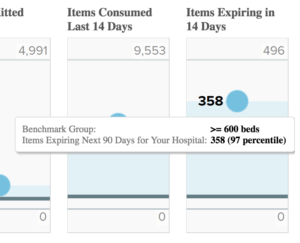Today we are excited to introduce our latest feature: Kit Check Benchmarking. This new capability allows pharmacy leaders to compare the effectiveness of their kit processing approaches to that of their peers. Only Kit Check customers can leverage the power of the cloud (and the crowd) to zero in on areas for improvement and showcase their successes to hospital leadership.

Pharmacy Benchmarking
Kit Check users can now access live, up-to-the-minute benchmarking metrics regarding drug expiration, consumption, and kit creation. Leveraging our cloud architecture, six parameters can now be compared across hospitals of similar bed size. Currently these parameters are:
- Number of Kits
- Number of Kit Masters
- Number of Items in Kits
- Expired Items in Kits
- Items Consumed in Trailing 14 Days
- Items Expiring in Coming 14 Days
Hospital Benchmarking: Surfacing the Question
Hospital automation solutions produce a TON of data, and Kit Check is no exception. But while those other solutions make it extremely difficult to use that data, we do things differently. Kit Check Benchmarking highlights areas for process improvement and gets you asking the right questions. Those questions, in turn, can then be answered by Kit Check’s other reports and analytics.
Let’s walk through an example. I recently looked at the benchmark comparisons for one of our hospitals in the Midwest and saw that their averages for expired and expiring drugs were well above their peers (90th and 97th percentiles, respectively).


Expired items have a significant impact on hospital pharmacy budgets every year so figuring out why this particular hospital was throwing away more than their peers, and what they could do to reduce that waste, seemed like a great question to answer.
Analytics and Data Visualizations: Providing the Answers
A quick peek at this hospital’s Expiration Analytics Report helped reveal at least part of the problem. To-date, 605 items have been removed from kits due to expiration, costing a total of $3,500. The worst offending drug? Rocuronium Bromide accounting for over half of those expirations and costs. My recommendation to this hospital would be to consider lowering the par levels for all rocuronium segments if possible and/or considering a non-refrigerated alternative like PharMEDium’s pre-compounded offering.

I also quickly ran our Advanced Segment Optimization report for this hospital. In this particular case, our analytics showed that this hospital carries 20 Ketorolac (30 mg/mL injectable) in their Electroconvulsive Therapy Anesthesia Tray. In 2016, the most Ketorolac ever consumed was a single unit. On average, zero (0) units were consumed. I also saw this same pattern for many other drugs. This hospital can save thousands of dollars by adjusting their current par levels to stock less and, therefore, buy less.

Business Decision Platform for Hospital Pharmacies
As Kit Check’s Analytics capabilities continue to expand, more Directors of Pharmacy are leveraging the solution to drive real business decisions within the organization. As the size of the Kit Check community grows, so will the collective intelligence of our cloud, which means even more meaningful insights for our customers. Are you interested in joining the Kit Check Community? Click below to have us contact you.
[su_button style=”flat” size=”6″ background=”#f97cec” radius=”1″ url=”/request-a-demo/” ]Request a Demo[/su_button]
Have other ideas on how we might help surface more questions and provide more answers? Please email me at analytics at kitcheck dot com.